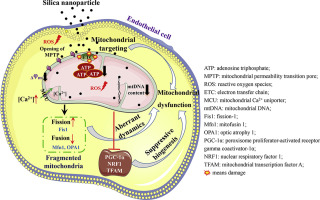Environmental Pollution ( IF 7.6 ) Pub Date : 2017-11-01 , DOI: 10.1016/j.envpol.2017.10.060 Caixia Guo , Ji Wang , Li Jing , Ru Ma , Xiaoying Liu , Lifang Gao , Lige Cao , Junchao Duan , Xianqing Zhou , Yanbo Li , Zhiwei Sun

|
As silica nanoparticles (SiNPs) pervade the global economy, however, the followed emissions during the manufacturing, use, and disposal stages inevitably bring an environmental release, potentially result in harmful impacts. Endothelial dysfunction precedes cardiovascular disease, and is often accompanied by mitochondrial impairment and dysfunction. We had reported endothelial dysfunction induced by SiNPs, however, the related mechanisms by which SiNPs interact with mitochondria are not well understood. In the present study, we examined SiNPs-induced mitochondrial dysfunction, and further demonstrated their adverse effects on mitochondrial dynamics and biogenesis in endothelial cells (HUVECs). Consequently, SiNPs entered mitochondria, caused mitochondrial swelling, cristae disruption and even disappearance. Further analyses revealed SiNPs increased the intracellular level of mitochondrial reactive oxygen species, eventually resulting in the collapse of mitochondrial membrane potential, impairments in ATP synthesis, cellular respiration and the activities of three ATP-dependent enzymes (including Na+/K+-ATPase, Ca2+-ATPase and Ca2+/Mg2+-ATPase), as well as an elevated intracellular calcium level. Furthermore, mitochondria in SiNPs-treated HUVECs displayed a fission phenotype. Accordingly, dysregulation of the key gene expressions (FIS1, DRP1, OPA1, Mfn1 and Mfn2) involved in fission/fusion event further certified the SiNPs-induced perturbation of mitochondrial dynamics. Meanwhile, SiNPs-treated HUVECs displayed declined levels of mitochondrial DNA copy number, PGC-1α, NRF1 and also TFAM, indicating an inhibition of mitochondrial biogenesis triggered by SiNPs via PGC-1α-NRF1-TFAM signaling. Overall, SiNPs triggered endothelial toxicity through mitochondria as target, including the induction of mitochondrial dysfunction, as well as the perturbations of their dynamics and biogenesis.
中文翻译:

二氧化硅纳米颗粒诱导的内皮损伤涉及线粒体功能障碍,线粒体动力学紊乱和生物发生
但是,随着二氧化硅纳米粒子(SiNPs)席卷全球经济,在制造,使用和处置阶段所产生的后续排放不可避免地会释放环境,从而可能产生有害影响。内皮功能障碍先于心血管疾病,并常常伴随着线粒体功能障碍和功能障碍。我们已经报道了由SiNPs诱导的内皮功能障碍,但是,关于SiNPs与线粒体相互作用的相关机制还不清楚。在本研究中,我们检查了SiNPs诱导的线粒体功能障碍,并进一步证明了它们对内皮细胞(HUVECs)的线粒体动力学和生物发生的不利影响。因此,SiNPs进入线粒体,导致线粒体肿胀,cr断裂甚至消失。+ / K + -ATPase,Ca 2+ -ATPase和Ca 2+ / Mg 2+-ATPase),以及细胞内钙水平升高。此外,SiNPs处理的HUVEC中的线粒体表现出裂变表型。因此,参与裂变/融合事件的关键基因表达(FIS1,DRP1,OPA1,Mfn1和Mfn2)的失调进一步证明了SiNPs诱导的线粒体动力学扰动。同时,经SiNPs处理的HUVECs的线粒体DNA拷贝数,PGC-1α,NRF1以及TFAM均下降,这表明SiNPs通过PGC-1α-NRF1-TFAM信号传导触发了线粒体生物发生的抑制作用。总体而言,SiNPs以线粒体为靶点触发了内皮毒性,包括线粒体功能障碍的诱导以及其动力学和生物发生的扰动。











































 京公网安备 11010802027423号
京公网安备 11010802027423号